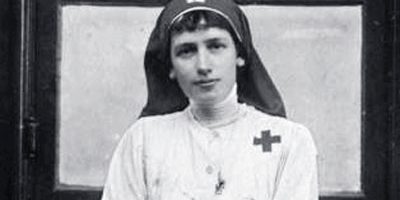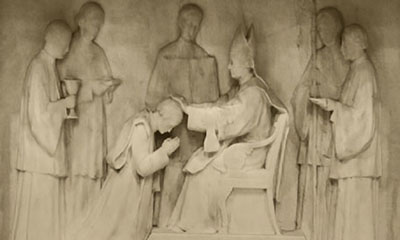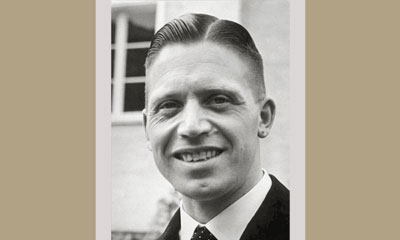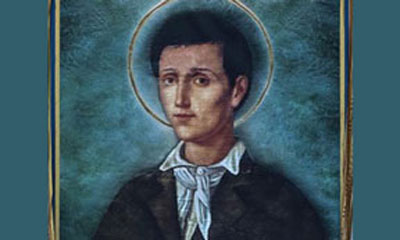May 22, 2019
Gabrielle Bossis
Dear Friends,
In the middle of the 20th century, a professional director watched the performance of an actress who received thunderous applause in Catholic parishes and clubs. Following the show, full of surprise and admiration, he asked her: “Madam, your laugh that brings joy to an entire hall, was it learned or is it natural?” Her response came in a burst of spontaneous, magnificent laughter: “Sir, I only have one laugh, this one!” Towards the end of her life, the thought of the success she could have had in cinema crossed her mind. But Jesus’ voice immediately interrupted: “I’ve kept you for Myself!” Indeed, starting in the mid-1930s, Gabrielle was blessed with a strong mystical life of inner locutions from Jesus, through which she developed a special intimacy with Him.
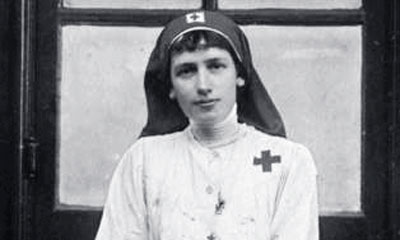 The last of four children, Gabrielle was born on February 26, 1874 in her parents’ town house in Nantes. Her brother, Auguste, and her two sisters, Clémence and Marie, were much older than her. In addition to the family’s property holdings, her father also ran a business selling boat repair parts. Each summer, the Bossis family left Nantes to spend their holidays at their house on the banks of the Loire River in Ingrandes (Le Fresne-sur-Loire). Mrs. Bossis paid special attention to her youngest daughter, providing her with an excellent Christian education. Gabrielle’s mother was so pious that her husband jokingly said: “I think she even recites the rosary at the table”. But her youngest daughter was painfully shy, and for many years was afraid of loud games, cried constantly, and dreaded the many gatherings she had to attend. However, no one pushed her, and her sensitive nature found refuge with Jenny, the nanny who worked for her family.
The last of four children, Gabrielle was born on February 26, 1874 in her parents’ town house in Nantes. Her brother, Auguste, and her two sisters, Clémence and Marie, were much older than her. In addition to the family’s property holdings, her father also ran a business selling boat repair parts. Each summer, the Bossis family left Nantes to spend their holidays at their house on the banks of the Loire River in Ingrandes (Le Fresne-sur-Loire). Mrs. Bossis paid special attention to her youngest daughter, providing her with an excellent Christian education. Gabrielle’s mother was so pious that her husband jokingly said: “I think she even recites the rosary at the table”. But her youngest daughter was painfully shy, and for many years was afraid of loud games, cried constantly, and dreaded the many gatherings she had to attend. However, no one pushed her, and her sensitive nature found refuge with Jenny, the nanny who worked for her family.
The Christian environment that surrounded little “Gaby”, as her family called her, allowed the faith she received at her baptism to spontaneously emerge in her childhood prayers, which she sometimes wrote down in a notebook: “Speak My Lord, your servant is listening!” The Lord did not forget any of the impulses of her heart towards Him, later reminding her: “Do you remember? When you were little, you said to Me: ‘Lord, open my heart to Your words.’ And I replied: ‘Tell Me what you did today.’ But you didn’t believe that it was My voice…”
Your dearest friend
Jesus thirsts to develop a personal relationship with each of us, as Saint Alphonsus Liguori teaches us: “Accustom yourself to speak with Him face-to-face, familiarly, with confidence and love, as to your dearest friend, who loves you best… Ask those souls who love Him with a true love, and they will tell you that in the trials of their life they find no greater and truer solace than in conversing lovingly with God. A continual focus on God that would make you forget your ordinary work or recreation is not required—only that, without neglecting your ordinary occupations, you should act towards God as you act towards those you love and who love you” (How to Converse with God, 6-7).
In Nantes, Gabrielle attended a school run by nuns, where she received her first Communion at the age of 12, on June 10, 1886. That day, it was not her shyness that kept her recollected, but rather the presence of Jesus: “The day of your first Communion,” the Lord reminded her, “you didn’t dare move, you were so aware that I was in you.” And one day, he pleaded with her: “Never abandon Me. Shouldn’t we always be there for each another?” She gently protested: “Lord, hasn’t it been that way since the day of my first Communion?”
As she reached the end of her adolescence and became a young woman with brown hair, she became more outgoing. After her father died in 1898, her mother brought her to Nice to spend winters there with her sister Clémence, who had health problems. Gabrielle developed a wide range of skills: she enjoyed hikes, horse-riding, and cycling, and took dance, piano, sculpture and painting lessons. The shyness of her early years transformed into a rigorous discretion: Gabrielle forgot herself in order to spread joy all around her. Yet she was undergoing an interior trial: “I was thought to be lighthearted in my youth, but that was the time my soul faced its greatest difficulties.” She sought the will of God with all her heart, and a priest suggested that she join the Poor Clares. But understanding that this was not the path along which the Lord wanted to lead her, she chose to remain celibate in the world. Gabrielle remained attached to Franciscan spirituality, becoming a Third Order Franciscan with the name of Sister Mary of the Heart of Jesus. She sought to live simply: her meals were frugal and she avoided all unnecessary spending. In her seventies, during a pilgrimage to Lourdes, she was content to sleep in a closet lit by a dormer window that was just big enough to fit a bed. Some accused her of stinginess, since she kept secret her gifts to the Missions and the poor. Her charity sometimes included “forgetting” to collect rent from tenants in need. “Do you know who My enemy is?” Jesus asked her one day. “It’s money! People think only of money. They live for it and nothing else. And it hardens hearts without filling it. I alone, you understand, I alone give joy.”
The genius of joy
As a slim, radiant, and graceful woman, Gabrielle did not go unnoticed; her charm conquered with its simplicity. Thus, she had to turn away over 70 suitors. Having become very sociable, she was vulnerable to the world’s temptations, from which she had to protect herself. One day, Jesus even had to plead with her to keep her whole heart for Him: “When you don’t recollect yourself, it is Me you deprive. Your life should be a constant recollection, a continual conversation with your Lord. Why do you leave Me? Me, I never leave you. Do not return to the world, for I will no longer be in your thoughts.” However, he did not want this intimacy to prevent her from carrying Him to others: “You must give joy… Don’t you feel that this is your mission? Be the genius of joy!”
In 1908, her mother returned to God, and four years later her sister Clémence also passed away. Since her other sister and brother had both long been married, Gabrielle’s solitude increased. Though the properties she inherited from her parents provided her with sufficient income, she did not remain idle, but ran a business making church ornaments for the Missions. After obtaining her nursing degree, she took care of the sick and wounded during the Great War, first in local hospitals, and then in Verdun. Everywhere she went, she was appreciated for her intelligence, her promptness, and her warmth. However, her family was not spared the terrible bloodshed of this global conflict: in 1918, Gabrielle mourned the loss of her favorite nephew, Jean Caron, who died at Verdun. “Aunt Gaby” always provided a warm welcome to all her nieces and nephews, and then their children, for holidays in Le Fresne-sur-Loire. In the garden overlooking the Loire River, she would sometimes interrupt the snack time or games of her young guests to say: “Hush! Listen to the silence!”
Transforming elephants into gazelles
In 1923, the priest of Le Fresne asked her to write a play for parish youth. She did so, acting and dancing herself with the youth. The play was such a success that Gabrielle was asked to perform the play in other parishes, and then to write new ones. From 1923 to 1936, she wrote thirteen comedies in three acts, and 14 sketches or ballets that she performed in until 1948. Her gifted acting, skillful directing, original taste, and graceful dancing won over her audiences. Through laughter and tears, she shared the Gospel in the many church clubs that existed at the time. Gabrielle herself made the costumes and directed the shows, sometimes with very little time to train the young and inexperienced actors. “Don’t worry about the ballets,” she once wrote. “I can teach them in 15 minutes. I’m used to transforming elephants into gazelles.” In 1929, in Paris, when Jesuit Father de Parvillez attended one of her shows for the first time, he fully agreed with the local pastor’s assessment: “One must admire the spirit of Miss Bossis’, but above all the spirit of faith that inspires her.” A correspondence then began between Gabrielle and the Jesuit.
In addition to the time she spent preparing her tours, for which she covered all the costs, Gabrielle also endured with patience all the discomforts of traveling: the nights spent in stations or trains, sleeping on suitcases or benches, often going without sleep and skipping meals. “You may forget your sufferings,” Jesus told her one day, “but they remain valuable to me”. “You have already forgotten the weariness of traveling, the heat and cold, the thirst, the worries, the distant exiles, the slow returns, the moments of courage, the sickness. Remember that you offered Me everything, and I have kept it all.” Many of those who met this unique and elegant lady always dressed in white, with wide-brimmed hats and old-fashioned dresses, never looked beyond her appearance. They envied her and imagined that life was easy for this now famous actress. Others criticized her, but Gabrielle followed Jesus’ advice: “Do not worry about what people say, do what you must.” Her secret was a life of prayer that was as intense as it was hidden. Even when traveling, she never missed daily Mass if at all possible, even if it meant getting up in the dark and walking several kilometers. In addition to the rosary, the Stations of the Cross, and the daily prayer, she tried to spend a Holy Hour every Thursday at a church in the company of Jesus in the tabernacle. She loved to contemplate Him in his painful Passion, in the Gospels, or in the writings of the mystics, particularly those of Blessed Anne-Catherine Emmerich or Sister Josefa Menendez.
It’s quite simple!
To forget about herself and think constantly about Jesus, Gabrielle made her body share in the sufferings Christ endured during his time on earth. Thus she would sleep on the floor rolled in a blanket, in a house that was never heated. One day, excitedly trying to encourage a priest’s fervor, she forgot her strict discretion and exclaimed: “But Father, we must mortify ourselves to go to Heaven! We must mortify ourselves… It’s quite simple!” And she showed him a hair shirt that she wore close to her skin. Such mortifications were not a natural inclination on her part, but rather the sign of her loyalty to the inspiration of Christ, her Well-Beloved, who sometimes encouraged her: “Never seek complete satisfaction, but keep a part mortified: My part.” One day, when she resisted sleeping on the floor, He asked her: “Don’t you think it took an effort to die on the Cross?” Or when she stopped wearing her hair shirt: “Me, I didn’t remove my crown of thorns, did I?”
In 1934, she had her tombstone engraved with the words: “Oh Christ, my Brother. To work close to You. To suffer with You. To die for You. To live in You.” And she wrote in her notebook: “I am readying my tombstone. I hope that when people pass by they have the good thought that Christ spoke through my dry bones.” Several years later, on the ‘Île-de-France’ liner which brought her to Canada to tour her play, Jesus began speaking clearly in the depths of her soul and she began keeping a journal of her journey. After Mass, she wrote “[Jesus], you know now that everything I do is for You, so I don’t say it.” Jesus replied: “You must say it because I love to hear it. Say it often. Even when you know someone loves you, you’re still happy when they say it.” The accounts of these conversations became more and more frequent during this lengthy tour on the other side of the Atlantic. Soon the Lord bid her: “I only ask this of you: write. It’s not so difficult. I am with you. Be my faithful one. I am your faithful one.” Later, however, she no longer kept journal of her many tours, which led her across France and all the way to Corsica, as well as Italy, Africa, Istanbul, and Palestine. Her silence was out of obedience: “Don’t talk about your travels anymore, they are for Me.”
For many years, Jesus? had been preparing Gabrielle for the special mystical grace of these inner locutions. In January 1941, he asked her: “Do you remember? When you were little and you looked for Me, you would hide in the darkened room behind your grandmother’s kitchen… When people asked: ‘Where is Gabrielle?’ you would think: ‘I am with the Good Lord.’ And remember, on summer nights in Le Fresne, when you would go by yourself onto the terrace, looking for Me between the Loire River and the stars. You would say: ‘I am going out to think…’ It was Me you were looking for. And I let you find Me, but you didn’t know it yet. Oh! How I have loved you, my little girl!” But when this inner dialogue became very clear and intense, Gabrielle became upset and wondered if it was not her imagination. She opened up about it with Father de Parvillez, who wisely discerned its divine origin. According to the Catechism of the Catholic Church, “Spiritual progress tends toward ever more intimate union with Christ. This union is called ‘mystical’ because it participates in the mystery of Christ through the sacraments—‘the holy mysteries’—and, in Him, in the mystery of the Holy Trinity. God calls us all to this intimate union with Him, even if the special graces or extraordinary signs of this mystical life are granted only to some for the sake of manifesting the gratuitous gift given to all” (CCC, # 2014). Thus the locutions Gabrielle received bore spiritual fruit for many when they were published.
Theatrical peregrinations
I
n 1938, her theatrical peregrinations brought her to Algeria, where she visited the tomb of Charles de Foucauld. In June 1940, the German invasion took the French by surprise. The occupation, hostage-taking, and requisition of houses forced residents into a sudden exodus. Gabrielle left her home, escaping in a cattle truck and taking refuge in Curzon, in the Vendée. There she continued to transcribe her dialogues with Jesus: “Oh how I have prayed for victory! ‘Do you want the salvation of the country,’ Jesus asked me, ‘or the salvation of souls? Consider that more important… Fear not. If the Germans come, it is Me in you who will receive them.’” At the end of the year, the German officers left her apartment in Nantes, and she was able to spend the winter there before joining her sister Marie in Ancenis, in order to be with her when she died. In 1943, Allied bombing devastated the city of Nantes, leaving many homeless. Gabrielle welcomed one of these unfortunate families into her home.
Father de Parvillez wanted to publish excerpts from Gabrielle’s conversations with Jesus, for which he obtained quick approval from the Bishop of Nantes, Msgr. Villepelet. Gabrielle knew these words were not only for her, but she preferred that they be published only after her death. However, her divine interlocutor convinced her to work on the publication herself. Despite difficult circumstances during the war, Father de Parvillez found an enthusiastic publisher to whom he entrusted Gabrielle’s journals. A few hours later, he was killed in the street. The manuscript was recovered, but it would take four years before a new publishing opportunity was found. The first volume of these spiritual conversations, entitled He and I, was prefaced by Bishop Villepelet and Father Jules Lebreton, Dean of the Faculty of Theology in Paris. The Bishop gave Pope Pius XII a copy in 1950. At Gabrielle’s explicit request, the publication was anonymous. In July 1948, she received the proofs of the book, and Jesus encouraged her to pray for its supernatural success: “Oh! My daughter, can you know the path this little book will take? Ask Me to reach the most wretched, the spiritually paralyzed, the hopeless abandoned souls, those mute before God, those consumed by a desire for money. Ask that through this little book I come as I once came, healing, drawing people to Myself.” The book was very successful, the first edition selling out in six months. It was followed by 60 or so more editions, and translated into several languages. This in no way changed Gabrielle’s daily life. The woman who was nicknamed “Ingrandes’ eternal youth” remained playful and mischievous until her dying day.
A little longer
For the first time, Gabrielle was required to reduce her nonstop activity. In August 1949, several weeks after the publication of the book, she had to undergo surgery for breast cancer. She was fully prepared to die for her Lord, but He asked her to work for Him a little longer. Gabrielle thus renewed her work, full of vigor, and began preparing the second volume of He and I. In mid-March 1950, she felt tired and sick. She thought she had bronchitis and didn’t think much of it. But doctors discovered that the cancerous tumor had reached her lungs. Gabrielle was confined to bed. She did not willingly accept this situation: “Doctor, when will you let me leave this bed?” His answer was: “I won’t!” She accepted everything simply, in silence. “I am leaving on the great journey. I have received Extreme Unction. Magnificat! It is time to return to the Father’s House!” However, her illness was too slow for this ardent soul, who had to overcome her impatience: “Since this death is inevitable, let it come!” She remained vivacious until the end, consoling with surprising wit and strength those who came to cry by her bedside, including her nieces and nephews, whom she asked to bury her in her Franciscan Third Order habit. However, she was alone for the great departure, on the night of June 9, 1950, the Feast of Corpus Christi. Jesus came to fulfill what he had promised her seven years earlier, on the anniversary of her first Communion: “At the moment of your death, I will be your swan song, for you will lack the strength: you will no longer have any tie to the earth nor any sight of the great beyond. It will be like My abandonment on Calvary: you will be more closely united than ever to My abandoned heart, and we will be together for the Passage.” The inscription on Gabrielle’s tombstone were her own words: “Oh Christ my Brother. To work close to You. To suffer with You. To die for You. To live in You.”
The earthly journey of Gabrielle Bossis remains an eloquent account of the extraordinary richness of a soul who refuses to be discouraged in their search for intimacy with Jesus. We can all hear Him say in the depths of our hearts, as Gabrielle did, even without the sound of His voice: “Send me your sighs, they will be as sweet as the breeze on the plains. I will welcome them with a joyful heart, as if there existed only one soul in the world, yours, and I will rejoice and celebrate it, each soul able to think itself my Chosen Beloved. This is the miracle of the Heart of your God, for each and every person, in the most intimate secret place of each. I am the Answer.”


